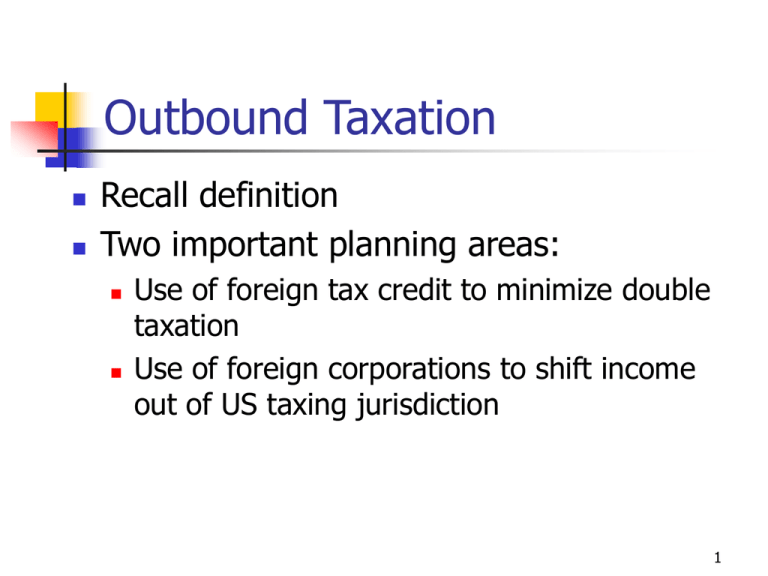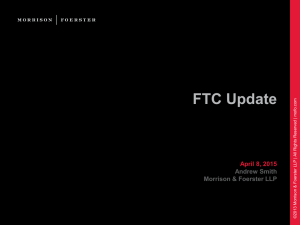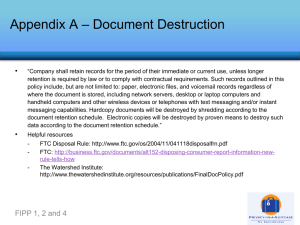Powerpoint slides for Chapters 10, 11, 12, and 13
advertisement

Outbound Taxation Recall definition Two important planning areas: Use of foreign tax credit to minimize double taxation Use of foreign corporations to shift income out of US taxing jurisdiction 1 Foreign Tax Credit - Overview Three big questions: Who gets a FTC? What are creditable foreign taxes? How much FTC is available each year? 2 Example 1: Taxpayers Eligible for the FTC Which of the following taxpayers is allowed a US foreign tax credit? US citizen earning income in France and paying French income tax US corporation with a branch office in Japan paying Japanese income tax Foreign corporation earning US income on which it pays both US and foreign taxes Nonresident foreign individual earning US 3 income subject to US and foreign taxes Creditable Foreign Taxes Must be a ‘tax’ or ‘in lieu of’ a tax Not a payment for any specific benefit, not related to transactions between the taxpayer and the government Special rules for splitting ‘dual-capacity’ payments Must be an ‘income’ tax Imposed on realized net gain derived from actual gross receipts 4 Figure 13-1 Types of Tax Collected as a Percentage of Total Tax Revenues for OECD Member Countries, 1997 Other Taxes 14% Personal Income Tax 27% Consumption Taxes 18% Corporate Income Tax 9% Property Tax 6% Social Security and Payroll Tax 26% 5 Foreign Income Tax Systems Rates range from zero to 42 percent (Canada and Japan) Imputation system for alleviating doubletaxation of corporate earnings Shareholders receive a tax credit for portion of corporate tax paid and report dividend income equal to dividend received plus credit amount Many other differences in computation of taxable income and tax liability 6 Value-Added Tax Systems Common in Europe and many other developed countries Consumption tax Assessed on producers and distributors of goods and services based on ‘value added’ at each stage of production and distribution Value-added generally equal to difference between sales price and non-labor costs of production or acquisition Rates can be as high as 20+ percent 7 Example 2: Creditable Foreign Taxes Which of the following foreign taxes are likely to be creditable? Value-added tax Excise tax Tax on gross receipts, with no allowance for deductions Customs taxes imposed on imports of raw materials Tax on net income computed under International Accounting Standards 8 Example 3: Splitting DualCapacity Payments BigOil Co. extracts oil with a gross value of $10 million from oil deposits owned by a foreign government. It incurs $2 million of operating expenses, and pays a 60% oil tax on its net profit. The foreign government’s normal income tax rate is 35%. How much of BigOil’s payment is considered a tax, and how much is a royalty? 9 Limits on Allowable FTC Concept: FTC is allowed only up to the amount of US taxes paid on foreign source income Mechanics: Credit = US Income X Foreign Source Income Limit Tax Worldwide Income Unused credits may be carried back 2 years and forward 5, subject to the limit in those years 10 Example 4: Applying the Overall FTC Limitation Global Inc., a US corporation, earned $4 million of worldwide taxable income, of which $1 million is foreign source. If Global paid $300,000 of foreign taxes, compute its US tax liability after allowable FTC and total tax burden What if Global paid $500,000 of foreign taxes? 11 FTC Limits – Separate Baskets FTC limit is applied separately for foreign taxes paid on income in separate baskets: Passive income High interest withholding income Financial services income Shipping income Dividends received by a corporation from each noncontrolled Sec. 902 corporation Dividends from a DISC or former DISC Foreign trade taxable income Distributions from a FSC 12 All other income Separate Basket Limits continued What is the goal of the separate basket limitations on the FTC? Do these limits increase or decrease taxpayers’ ability to use FTCs? What do many of the separate baskets have in common? Note: Overall limit applies after the separate basket limitations 13 Example 5: Applying the FTC Basket Limitations Refer to example 3. Suppose that Global’s foreign source income is composed of $600,000 of passive income and $400,000 of shipping income. All $300,000 of its foreign taxes paid relate to the passive income. Compute Global’s separate basket FTC limitations, its US tax liability after FTC, and its total tax burden. 14 Cross-Crediting Opportunities and Limits Cross-crediting is advantageous when some foreign income is taxed at a low foreign tax rate while other foreign income is taxed at a high foreign tax rate Cross-crediting is possible only when both sources of income are in the same basket, or when both sources of income are in the general basket 15 Example 6: Cross-Crediting and the FTC Nova Corporation earned $1 million of foreign income in country A, on which it paid foreign income tax of $100,000, and $1.5 million in country B on which it paid tax of $600,000. Its US source income is $3 million. If all of Nova’s foreign income is in the general basket, calculate its allowable FTC and net US tax liability. What if Nova’s two foreign income sources are in separate baskets (or if per-country FTC limits applied)? 16 Conclusions What are the burdens imposed by the FTC rules? Information gathering and compliance burdens? Impact on after-tax return from investment in foreign jurisdictions? What planning opportunities can you identify related to the FTC? 17







